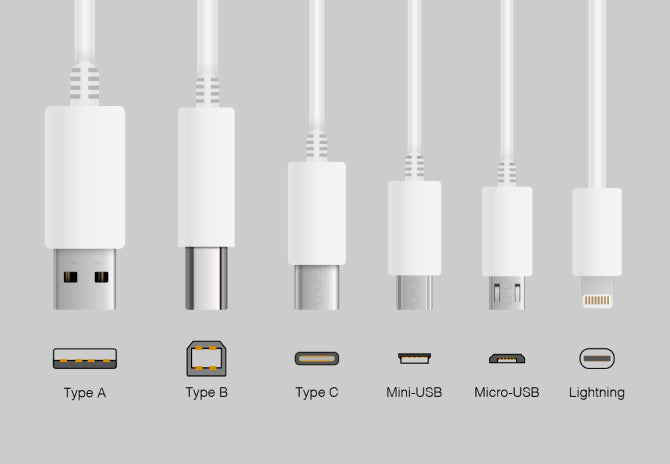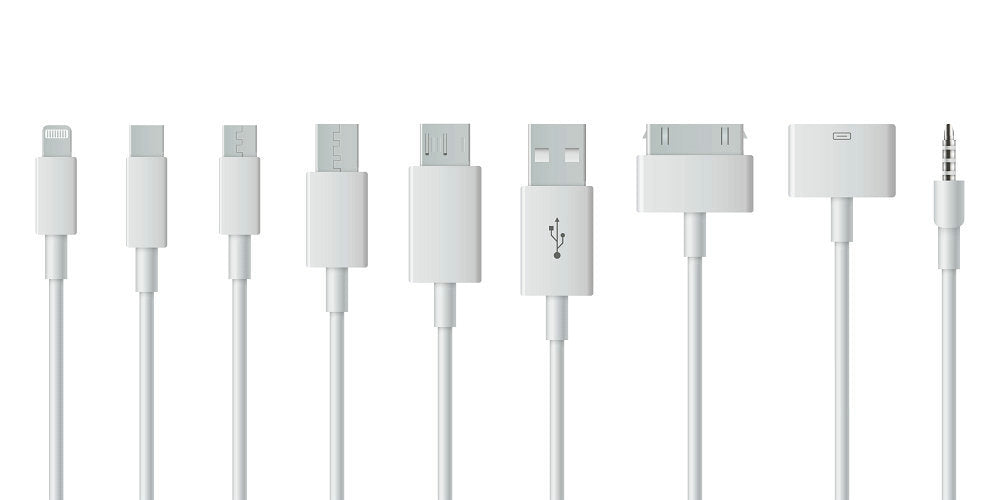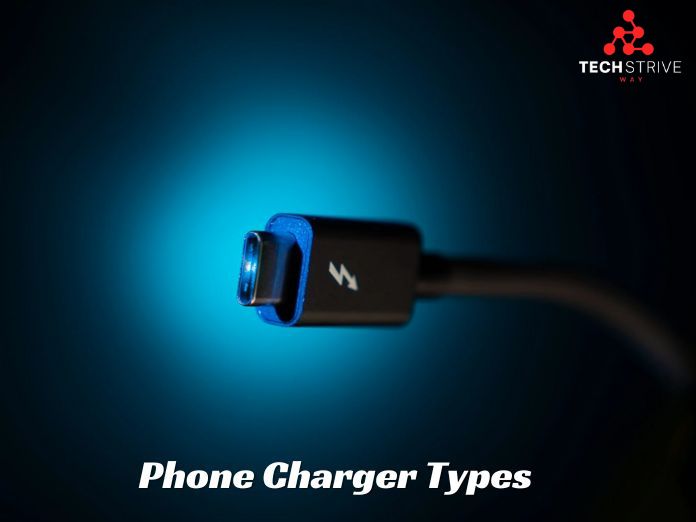Phone chargers come in several types, including USB-A, USB-C, and Lightning connectors. Each type serves different devices and charging speeds.
Understanding phone charger types is crucial in today’s tech-driven world. With various devices and fast charging options, knowing which charger to use can enhance your charging experience. USB-A is the standard for older devices, while USB-C is becoming the norm for newer smartphones and laptops.
Lightning connectors are specific to Apple products. Fast chargers can significantly reduce charging time, making them a popular choice. Choosing the right charger ensures compatibility and efficiency, preventing damage to your device. This guide will help you navigate the different types of phone chargers and their specific uses, ensuring you always have the right tool for the job.
The Evolution Of Phone Chargers
Phone chargers have transformed dramatically over the years. From large, heavy devices to sleek, compact designs, they have become more efficient and user-friendly. Understanding this evolution helps us appreciate modern technology. Let’s explore how phone chargers have changed.
From Bulky To Sleek: Charger Design Over The Years
Charger designs have evolved significantly. Early chargers were bulky and cumbersome. They took up space and were hard to carry. Now, designs focus on portability and style.
- 1990s: Large, box-like chargers.
- 2000s: Slightly smaller, but still heavy.
- 2010s: Compact and lightweight models.
- Present: Sleek, minimalistic designs with various colors.
Technological Advancements In Charging
Technological innovations have made charging faster and more efficient. Here are some key advancements:
| Type of Charger | Charging Speed | Year Introduced |
|---|---|---|
| Standard USB | 5V/0.5A | 1996 |
| USB-C | 5V/3A | 2014 |
| Fast Charging | 9V/2A | 2015 |
| Wireless Charging | Up to 15W | 2017 |
Modern chargers support faster speeds. They enhance user convenience and reduce waiting time. Wireless options add freedom from cords. Understanding charger evolution helps users choose the right one. The right charger enhances device performance and user experience.

Credit: www.mietubl.com
Understanding Voltage, Amperage, And Wattage
The Basics Of Electrical Measurements
Three main terms describe how electricity works:- Voltage (V): This is the force of electricity.
- Amperage (A): This measures the flow of electric current.
- Wattage (W): This shows the total power used.
| Term | Definition |
|---|---|
| Voltage (V) | Force that pushes electric current. |
| Amperage (A) | Amount of electric current flowing. |
| Wattage (W) | Power used by the device. |
What Your Phone Needs To Charge Efficiently
Your phone requires specific values to charge quickly:- Most smartphones need 5V for charging.
- Amperage can vary, but 1A to 2A is common.
- Wattage generally ranges from 5W to 20W.
- Look for the voltage rating.
- Find the amperage output.
- Note the total wattage.
USB Chargers: The Universal Solution
USB Types And Compatibility
Different USB types exist, each designed for specific needs. Here’s a brief overview:| USB Type | Connector Shape | Common Use |
|---|---|---|
| USB-A |  |
The standard for most chargers |
| USB-B |  |
Used for printers and some devices |
| Micro USB |  |
Common in older smartphones |
| USB-C |  |
The new standard for modern devices |
The Emergence Of USB-c
USB-C has changed the charging landscape. It offers faster charging and data transfer. Many new devices now feature USB-C ports. This includes smartphones, laptops, and tablets.- Reversible design for easy plug-in.
- Supports higher power delivery.
- Compatible with various devices through adapters.
Wall Chargers: A Staple In Phone Charging
Wall chargers are essential for keeping our devices powered. They provide a reliable source of energy. Most users depend on them daily. Understanding their features helps in making better choices.
The Convenience Of Fast Charging
Fast-charging technology is a game-changer for busy lives. It allows users to quickly recharge devices. Here are some benefits of fast charging:
- Speed: Charge your phone in less time.
- Efficiency: Less time plugged in means more time on the go.
- Convenience: Perfect for quick top-ups during breaks.
Many modern devices support fast charging. Always check compatibility before buying. Fast chargers often come with specific power ratings. Most commonly, they range from:
| Charger Type | Power Rating (W) |
|---|---|
| Standard Charger | 5W |
| Fast Charger | 18W – 30W |
| Super Fast Charger | 45W and above |
Choosing The Right Wall Charger For Your Device
Selecting the correct wall charger is crucial. Not all chargers work with every device. Here are key factors to consider:
- Compatibility: Ensure the charger matches your device’s requirements.
- Power Output: Choose a charger that provides sufficient wattage.
- Brand Quality: Opt for reputable brands to ensure safety.
- Port Type: Check if your device uses USB-C, Micro USB, or Lightning.
Using the wrong charger can damage your device. Always follow manufacturer guidelines. Investing in a quality wall charger pays off in the long run.
Wireless Chargers: The Future Of Convenience
Wireless chargers are changing how we power our devices. They offer a sleek, hassle-free way to keep our phones charged. No more tangled cords or searching for an outlet. Just place your device on the pad and watch it charge.
How Wireless Charging Works
Wireless charging uses electromagnetic fields to transfer energy. Here’s how it works:
- The charger has a coil that creates a magnetic field.
- Your phone has a receiver coil inside it.
- When you place your phone on the charger, energy transfers.
- This energy charges the battery without cords.
This technology is known as inductive charging. It’s safe and efficient. Many new phones support this feature. Look for the Qi standard for compatibility.
Pros And Cons Of Cutting The Cord
Wireless charging has both benefits and drawbacks. Here’s a quick overview:
| Pros | Cons |
|---|---|
| Convenient and easy to use | Slower charging speed compared to wired |
| Reduces wear on charging ports | May require specific charging pads |
| Cleaner look without cables | Can be more expensive |
In summary, wireless chargers enhance convenience. They simplify charging but may sacrifice speed. Consider your needs when choosing a charging method.

Credit: uk.gpbatteries.com
Car Chargers: Staying Powered On The Go
Car chargers keep your devices powered while traveling. They provide a quick way to recharge smartphones, tablets, and other gadgets. With a good car charger, you can ensure your devices stay functional during long drives.
Features To Look For In A Car Charger
Choosing the right car charger is essential. Here are key features to consider:
- USB Ports: Multiple ports allow charging several devices.
- Fast Charging: Look for chargers with Quick Charge technology.
- Compatibility: Ensure it works with your device type.
- Cable Length: Longer cables offer flexibility for use.
- Compact Design: A small size saves space in your car.
The Safety Of Charging While Driving
Safety is crucial when charging on the road. Here are some tips:
- Secure the Charger: Ensure it stays plugged in during use.
- Avoid Distractions: Don’t fiddle with devices while driving.
- Use Smart Chargers: They prevent overheating and overcharging.
- Keep It Out of Reach: Store devices safely while charging.
Choose a charger with built-in safety features. This helps protect your devices and passengers.
Portable Chargers: Power Banks For The Nomad
Portable chargers, also known as power banks, are essential for travelers. They keep your devices charged on the go. No one wants a dead phone while exploring new places. Power banks offer convenience and peace of mind for modern nomads.
Capacity And Portability Trade-offs
Choosing a power bank involves balancing capacity and portability. Higher capacity means more charges but often increases size. Smaller power banks are easier to carry but have less power.
| Capacity (mAh) | Average Charges | Size (inches) |
|---|---|---|
| 5,000 mAh | 1 Charge | 4.3 x 2.6 |
| 10,000 mAh | 2 Charges | 5.5 x 2.9 |
| 20,000 mAh | 4 Charges | 6.3 x 3.1 |
- High Capacity: Ideal for long trips.
- Compact Size: Perfect for daily commuting.
- Weight: Heavier models offer more power.
Consider your needs before buying. A bigger power bank is great for trips. A smaller one suits daily use better.
Solar-powered Chargers: Harnessing Natural Energy
Solar-powered chargers are eco-friendly. They use sunlight to recharge devices. Perfect for outdoor adventures, they provide energy in remote areas.
- Advantages:
- Renewable energy source
- Ideal for camping or hiking
- Reduces reliance on electricity
- Considerations:
- Slower charging times
- Weather dependent
- Usually bulkier than regular power banks
Solar chargers are perfect for the eco-conscious traveler. They offer a sustainable option for charging devices outdoors.
Charging Cables: The Lifeline Of Your Charger
Charging cables play a crucial role in keeping your devices powered. They connect your charger to your smartphone or tablet. Understanding different cable types helps you make better choices. A good cable ensures fast and efficient charging.
Cable Length And Material
Choosing the right length and material for your charging cable is essential. Here are some key points:
- Length: Common lengths include 1 meter, 2 meters, and 3 meters.
- Short cables are great for portability.
- Long cables offer flexibility for use in various settings.
The material also matters:
- USB-C: Fast charging and data transfer.
- Lightning: Ideal for Apple devices.
- Micro-USB: Widely used in older devices.
Quality materials prevent wear and tear. Look for cables with reinforced connectors.
Signs Of A Deteriorating Cable
A deteriorating cable can slow down charging. Watch for these signs:
- Fraying: Exposed wires indicate wear.
- Intermittent charging: The device only charges sometimes.
- Overheating: Cables should remain cool during use.
- Physical damage: Cracks or bends can affect performance.
Regularly check your cables. Replace them if you notice any of these issues. Using a damaged cable can harm your device.
The Impact Of Fast Charging On Battery Health
Understanding The Trade-offs
Fast charging uses higher voltage and current. This speeds up charging times significantly. However, it can generate extra heat. Heat is damaging to lithium-ion batteries.- Increased heat can reduce battery life.
- Fast charging may cause battery swelling.
- Frequent fast charging can lead to capacity loss.
Maintaining Battery Longevity While Using Fast Chargers
To protect battery health, follow these tips:- Use original chargers designed for your device.
- Avoid charging in hot environments.
- Limit fast charging to urgent situations.
- Allow batteries to cool before charging.
- Regularly update your device software.
Charger Safety And Maintenance Tips
Understanding charger safety is vital for device longevity. Proper maintenance ensures your charger works effectively. Follow these tips to avoid hazards and extend charger life.
Avoiding Common Charging Hazards
Stay safe while charging. Here are key practices:
- Use certified chargers. Avoid cheap knock-offs.
- Inspect cables regularly. Look for fraying or damage.
- Avoid overcharging. Unplug when fully charged.
- Keep chargers cool. Don’t cover them while charging.
- Use the correct voltage. Match charger to device requirements.
Proper Charger Storage For Longevity
Storing chargers correctly helps prevent damage. Follow these tips:
- Store in a dry place. Moisture can cause short circuits.
- Avoid bending cables. Keep them straight to prevent breakage.
- Use cable ties. Keep cables organized and untangled.
- Keep away from heat sources. Heat can damage chargers.
- Label chargers. Helps identify which charger belongs to which device.
| Tip | Description |
|---|---|
| Use certified chargers | Prevents damage and hazards. |
| Inspect cables | Identifies fraying or wear. |
| Avoid overcharging | Protects battery health. |
| Keep chargers cool | Reduces overheating risks. |
Environmental Considerations And Sustainability
The E-waste Problem
E-waste refers to electronic waste. Phone chargers contribute significantly to this issue. Millions of chargers are discarded yearly. They contain harmful materials like lead and mercury. Improper disposal can lead to soil and water contamination. Here are some shocking facts:- Over 50 million tons of e-waste are produced annually.
- Only 20% is recycled properly.
- Charger waste grows 3-5% each year.
Eco-friendly Charging Solutions
Eco-friendly chargers promote sustainability. Here are some options:- Solar Chargers: Use sunlight to charge devices.
- Universal Chargers: Compatible with multiple devices.
- Energy-Efficient Chargers: Lower energy consumption while charging.
| Charger Type | Benefits | Considerations |
|---|---|---|
| Solar Charger | Renewable energy source | Weather-dependent |
| Universal Charger | Reduces e-waste | Compatibility issues |
| Energy-Efficient Charger | Lower electricity bills | May cost more upfront |

Credit: ventiontech.com
Future Trends In Phone Charging Technology
The future of phone charging technology is bright and exciting. Innovations are set to change how we charge our devices. Faster, safer, and more efficient charging methods are on the horizon. Let’s explore what’s coming next.
Emerging Innovations In Charger Tech
Several new technologies are changing the charging landscape. Here are some key innovations:
- Wireless Charging: More devices will support wireless charging. This eliminates the need for cables.
- Fast Charging: New chargers will deliver power quicker than ever.
- Solar Charging: Solar-powered chargers will gain popularity for eco-friendly users.
- Smart Chargers: These chargers will adjust power levels based on device needs.
What To Expect In The Next Decade
The next decade will bring even more advancements. Here are some expectations:
- Universal Charging Standards: A single charger type for all devices.
- Longer Battery Life: Batteries will last longer between charges.
- Biodegradable Chargers: Eco-friendly materials will be used in chargers.
- Integration with Smart Homes: Chargers will connect seamlessly to smart home devices.
The table below summarizes the expected trends:
| Trend | Description |
|---|---|
| Universal Charging | One charger for all devices. |
| Longer Battery Life | Batteries will last longer. |
| Eco-Friendly Chargers | Chargers are made from biodegradable materials. |
| Smart Integration | Chargers will work with smart home systems. |
Stay tuned for these exciting developments in phone charging technology!
Frequently Asked Questions
What Are The Common Phone Charger Types?
Common phone charger types include USB-A, USB-C, Lightning, and wireless chargers. Each type has unique compatibility and charging speeds.
How To Choose The Right Charger?
Selecting the right charger depends on your device’s compatibility and required charging speed. Always check specifications before purchasing.
Can I Use Any Charger For My Phone?
Using any charger is risky. Always opt for chargers that match your device’s voltage and amperage for safe charging.
Conclusion
Choosing the right phone charger is essential for optimal device performance. Understanding different charger types helps you make informed decisions. Whether you need fast charging or portability, there’s an option for everyone. Stay informed to ensure your devices stay powered and ready to go.
Happy charging!


Lots of great info and easy to understand,thank you!
I am not at all tech savvy and I was looking for information about an adapter to use some of my iPhone 14 cords on my iPhone 16. Is there such a thing?
купить аккаунт с прокачкой магазин аккаунтов
маркетплейс аккаунтов продажа аккаунтов соцсетей
биржа аккаунтов https://magazin-akkauntov-online.ru/
маркетплейс аккаунтов маркетплейс аккаунтов соцсетей
маркетплейс аккаунтов соцсетей аккаунт для рекламы
маркетплейс аккаунтов соцсетей магазин аккаунтов социальных сетей
продажа аккаунтов платформа для покупки аккаунтов
Account Buying Service Social media account marketplace
Secure Account Sales Account Selling Platform
Profitable Account Sales Sell Account
Verified Accounts for Sale Ready-Made Accounts for Sale
Gaming account marketplace Account Selling Service
Account Buying Service Buy Account
Account marketplace Account Trading Platform
Accounts marketplace Sell Account
account selling service verified accounts for sale
account trading platform account trading platform
gaming account marketplace account market
marketplace for ready-made accounts purchase ready-made accounts
accounts market account acquisition
secure account sales account purchase
marketplace for ready-made accounts buy accounts
verified accounts for sale buy account
account catalog database of accounts for sale
database of accounts for sale accounts marketplace
The evolution of encryption technology has been crucial for protecting our digital communications. Seeing end-to-end encryption become standard in messaging apps shows how security can be built into the tools we use daily. It’s wonderful that strong privacy protection is becoming the default rather than an option.
buy accounts account purchase
account buying platform verified accounts for sale
online account store online account store
account selling service account catalog
account sale accounts for sale
account store purchase ready-made accounts
buy pre-made account accounts market
account selling service buy and sell accounts
website for selling accounts account buying platform
sell pre-made account purchase ready-made accounts
account selling platform sell pre-made account
secure account purchasing platform buy and sell accounts
online account store https://accounts-marketplace.xyz/
social media account marketplace https://buy-best-accounts.org
buy and sell accounts account market
account buying platform accounts market
buy accounts https://buy-accounts.space/
website for selling accounts https://buy-accounts-shop.pro
account trading service buy accounts
ready-made accounts for sale https://accounts-marketplace.online
website for selling accounts https://accounts-marketplace-best.pro
покупка аккаунтов kupit-akkaunt.xyz
магазин аккаунтов https://akkaunt-magazin.online
магазин аккаунтов akkaunty-dlya-prodazhi.pro
купить аккаунт kupit-akkaunt.online
facebook ads account for sale https://buy-ad-accounts.click
buy account facebook ads https://buy-ad-account.top
buying facebook accounts https://buy-ads-account.click
facebook ad accounts for sale https://ad-account-for-sale.top
buy facebook accounts buy fb account
В этом обзорном материале представлены увлекательные детали, которые находят отражение в различных аспектах жизни. Мы исследуем непонятные и интересные моменты, позволяя читателю увидеть картину целиком. Погрузитесь в мир знаний и удивительных открытий!
Подробнее тут – https://medalkoblog.ru/
buy google ads account google ads agency account buy
buy fb account https://buy-accounts.click
google ads reseller https://buy-ads-invoice-account.top
google ads account buy https://buy-account-ads.work
buy google ads verified account https://sell-ads-account.click
buy account google ads https://buy-verified-ads-account.work/
unlimited bm facebook https://buy-business-manager-acc.org
buy facebook business manager account facebook bm for sale
buy verified facebook https://buy-verified-business-manager.org/
facebook bm buy verified business manager for sale
tiktok ads agency account https://buy-tiktok-ads-account.org
tiktok ads agency account https://tiktok-agency-account-for-sale.org
buy tiktok ads account https://buy-tiktok-ads-accounts.org
buy tiktok ad account https://buy-tiktok-business-account.org
tiktok ads agency account https://buy-tiktok-ads.org
tiktok ads account buy https://tiktok-ads-agency-account.org
лига чемпионов футбол https://www.footballnews.store .
1win футбол 1win футбол .
1вин официальный сайт мобильная http://www.1win22080.ru .
mostbet casino oyunları mostbet3043.ru .
mostbet uz telegram qo‘llab-quvvatlash http://mostbet3031.ru .
mostbet yuklab olish http://mostbet3030.ru/ .
ставки на спорт бишкек онлайн 1win14004.ru .
mostbet blackjack https://www.mostbet3042.ru .
клинические анализы http://medanalyze.ru/ .
доставка еды доставка еды .
доставка готовой еды в челябинске https://dostavka-edy-bf12.ru .
доставка еды челябинск круглосуточно доставка еды челябинск круглосуточно .
mostbet uz ro‘yxatdan qanday o‘tish http://mostbet3031.ru .
mostbet az aviator mostbet az aviator .
клинические анализы https://medanalyze.ru/ .
доставка еды челябинск круглосуточно доставка еды челябинск круглосуточно .
доставка еды на дом челябинск доставка еды на дом челябинск .
доставка еды челябинск круглосуточно доставка еды челябинск круглосуточно .
1win demo aviator o‘ynash 1win demo aviator o‘ynash .
mostbet az apk yüklə https://mostbet3043.ru/ .
1win texnik yordam http://1win14006.ru/ .
mostbet login mostbet login .
Инъектирование стен https://usileniekonstrukcij3.ru/ .
Выбрать гидроизоляцию Выбрать гидроизоляцию .
Усиление конструкций работа Усиление конструкций работа .
Инъектирование кирпичной кладки http://usileniekonstrukcij2.ru .
mostbet ru mostbet ru .
скачать игру авиатор скачать игру авиатор .
ставки на спорт бишкек https://mostbet20005.ru .
1win foydalanuvchi fikrlari http://1win14008.ru .
mostbet akkaunt yaratish mostbet akkaunt yaratish .
1вин вывод средств 1вин вывод средств .
mostbet ios http://mostbet3032.ru/ .
скачать мостбет http://mostbet20005.ru .
скачать бесплатно 1win скачать бесплатно 1win .
mostbet az bonusları https://mostbet3044.ru .
1вин скачать на айфон http://1win22081.ru .
mostbet az giriş https://mostbet3044.ru .
1win virtual sport 1win virtual sport .
mostbet azerbaycan https://mostbet3045.ru .
mostbet depozit bonusu mostbet depozit bonusu .
mostbet bonus http://www.mostbet3033.ru .
1win ilova bilan ro‘yxatdan o‘tish http://1win14007.ru/ .
1win ro‘yxatdan o‘tish bonusi 1win ro‘yxatdan o‘tish bonusi .
1win uz sport tikish https://1win14009.ru .
что такое бонусы казино в 1win 1win22084.ru .
mostbet bonus ro‘yxatdan so‘ng mostbet bonus ro‘yxatdan so‘ng .
1win ios yuklab olish https://1win14009.ru .
mostbet uz sport tikish mostbet uz sport tikish .
трэки http://www.klubnaya-muzyka13.ru .
диджей онлайн диджей онлайн .
Гидроизоляция работа Гидроизоляция работа .
Гидроизоляция зданий Гидроизоляция зданий .
mostbet aviator oyunu mostbet aviator oyunu .
клубные сеты миксы http://www.klubnaya-muzyka13.ru/ .
dj онлайн dj онлайн .
mostbet virtual idman http://mostbet3046.ru/ .
Усиление конструкций работа Усиление конструкций работа .
Гидроизоляция работа Гидроизоляция работа .
клубные сеты диджеев клубные сеты диджеев .
трэки http://www.klubnaya-muzyka11.ru .
mostbet uz app yuklab olish http://mostbet3036.ru .
mostbet uz futbol tikish mostbet uz futbol tikish .
1 вин ставки на спорт 1 вин ставки на спорт .
связной айфон связной айфон .
официальный магазин apple в спб официальный магазин apple в спб .